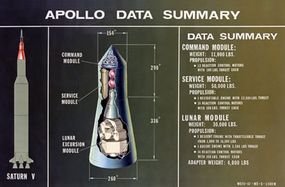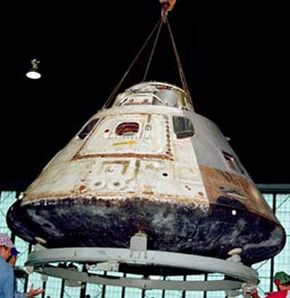CSM Systems and Controls
The systems aboard the CSM fulfilled a range of functions, including navigation, guidance, communication, life support, electrical power, water management and propulsion.
Here's a quick breakdown on the systems in the CSM:
Advertisement
- Electrical power system (EPS): The EPS consisted of fuel cells and batteries and provided both direct and alternating current electricity. Most of the EPS's systems were in the SM, but the CM carried three batteries.
- Guidance, navigation and control system (GNCS): The purpose of this system was to measure and control the spacecraft's position, attitude and velocity. The GNCS included inertial, optical and computer subsystems. The inertial subsystem used accelerometers to measure the spacecraft's speed and rotation along its three axes. The optical system included a telescope, a sextant and an electronic system that sent optical data to the spacecraft's computer for navigation purposes. The computer system analyzed data from the other subsystems as well as from manual commands from astronauts. Then the computer would send the commands to the spacecraft's propulsion system to make course adjustments. The computer also had a digital autopilot that could control the spacecraft during all phases of the mission.
- Stabilization and control system (SCS): This system included controls and displays for the crew of the Apollo to adjust the spacecraft's rotation or velocity manually. The system sent commands to the spacecraft's propulsion system.
- Service propulsion system: Located in the SM, this propulsion system included four tanks of hydrazine fuel and nitrogen tetroxide oxidizer. These substances are hypergolic, which means they ignite spontaneously when mixed together. The system used helium tanks to pressurize the fuel lines. The system's rocket engine produced up to 20,500 pounds (91,225 Newtons) of thrust. NASA mounted the engine on a gimbal, which is a support that can pivot. By pivoting the engine in the right direction, the spacecraft could maneuver to the right attitude and trajectory.

Image courtesy NASA
- Reaction control systems (RCS): The RCS was a system of engines and fuel tanks. It was partly used as a redundant system, meaning it could control the spacecraft's movement if the main propulsion system went offline. Both the CM and SM had an independent RCS. The SM had four quads, which were groups of four rocket engines. Each engine could supply 100 pounds (445 newtons) of thrust. The CM had two six-engine groups, with each engine capable of supplying 93 pounds (413.9 newtons) of thrust. The CM's RCS also provided spacecraft control during re-entry.
- Telecommunication system: This system provided intercommunication between the astronauts in space and staff back on Earth as well as between the astronauts themselves. It included S-band and very high frequency (VHF) radio transmitters and receivers and a transponder. Astronauts used the VHF equipment for short-range communication and the S-band equipment to communicate across deep space. Whenever a large body -- for example, the moon -- was between the spacecraft and the flight crew on the ground, communication was lost.
- Environmental control system (ECS): This system controlled the spacecraft's atmospheric pressure and temperature and also managed water. It collected water from the ship's fuel cells (a useful byproduct). The ECS adjusted the temperature in the CSM through a water and glycol cooling system. The system pumped the water and glycol through coolant loops to reduce the temperature of the liquid. Then the system pumped the liquid through tubes to cool the CSM's atmosphere and electric systems, much like a liquid-cooled computer's cooling system.
- Earth landing system: Housed in the CM, this system consisted of several mortar-deployed parachutes. NASA designed the Apollo spacecraft with the intention of a water landing upon re-entry. The parachutes slowed the spacecraft's descent enough to ensure the safety of the crew inside the spacecraft.
Think that's a lot of information? The list above just scratches the surface of the CSM's systems and controls, and we haven't even looked at the lunar module yet. Read on to find out how that feat of engineering worked.
